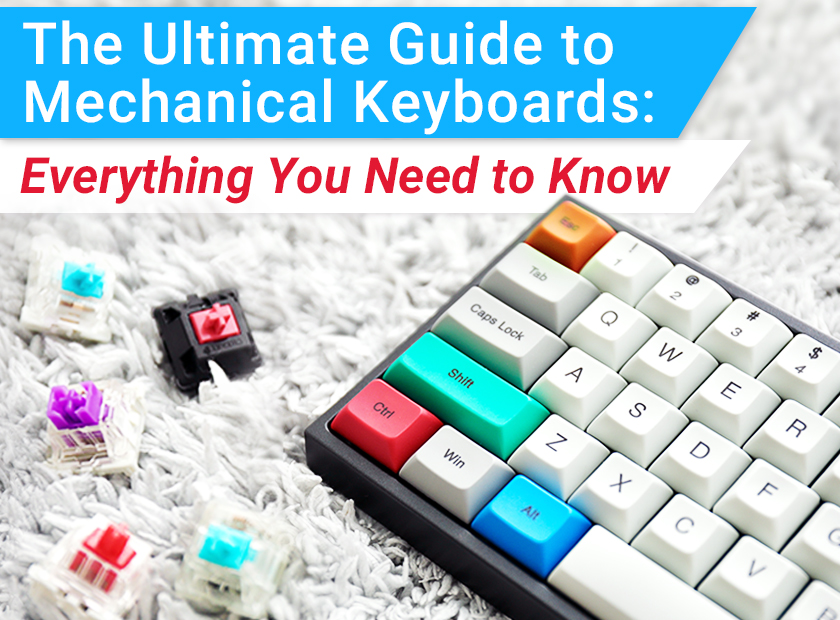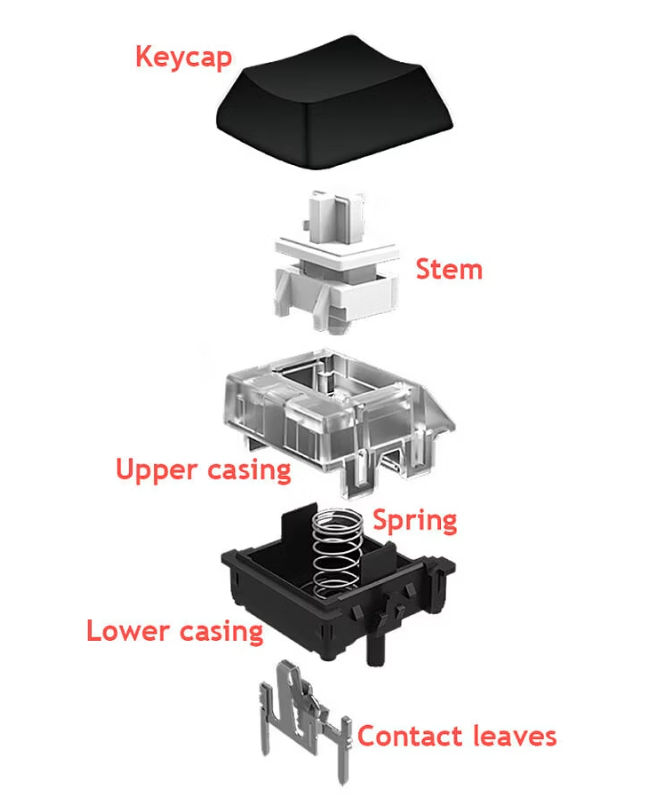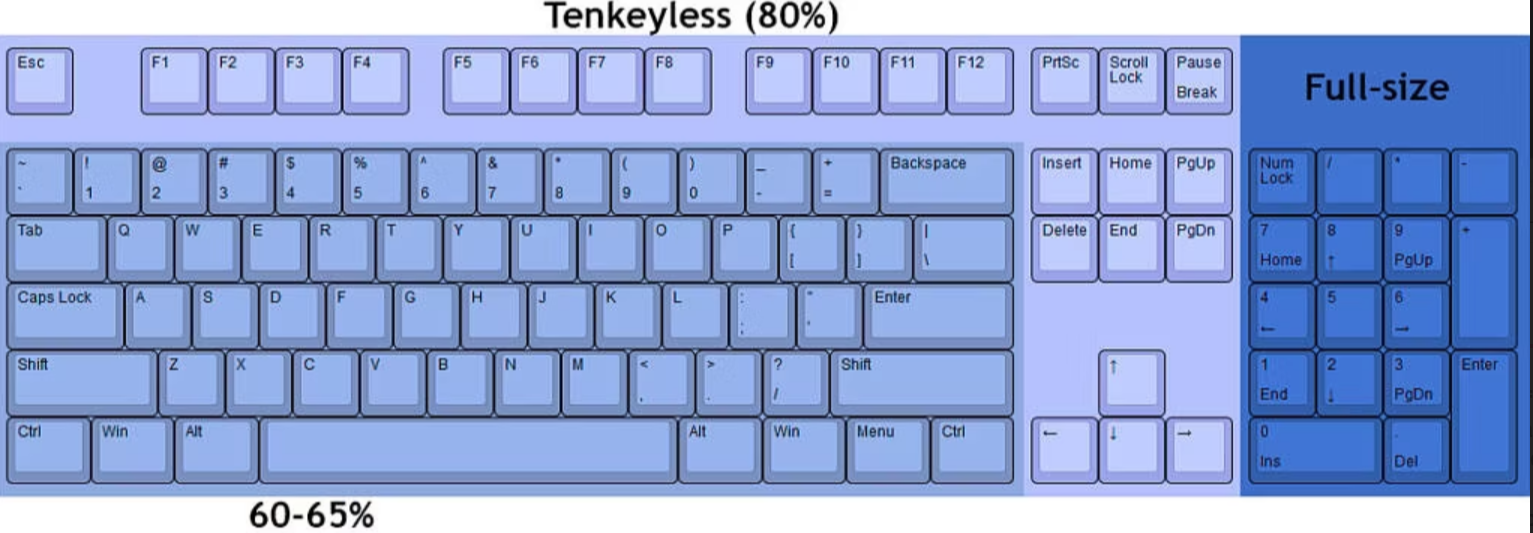The Ultimate Guide to Mechanical Keyboards: Everything You Need to Know

The Ultimate Guide to Mechanical Keyboards: Everything You Need to Know
What Is A Mechanical Keyboard?
A mechanical keyboard is a computer keyboard that utilizes spring-loaded switches.
Nowadays, only high-end keyboards use key switches, although in the past, for example, IBM's Model M keyboard used folding spring switches.
A mechanical keyboard uses discrete parts that can be customized in any way imaginable, unlike the scissor switch keyboards found on modern laptops or the rubber membrane keyboards found on most PCs.
Mechanical keyboards are appreciated by fast typists because they have a springiness and feel unlike the cheap membrane keyboards that come with most computers. They are also preferred by gamers.
How does a mechanical keyboard work?
To understand how a mechanical keyboard works, let's first understand the mechanical keyboard switch. Each key on a mechanical keyboard has its own switch. At the top of the key switch is the keycap, not necessarily a component of the mechanical switch, but the place where your fingers press the switch and is partly responsible for the sound that is made when you press the key.
The keycap determines the actuation and travel of the switch and is attached to a stem, which comes in a variety of designs. It sits in a two-piece housing that keeps it in alignment. The upper part of the housing keeps the stem centered on the switch. The spring that comes with it prevents the stem from popping out.
A spring controls the amount of pressure required to register a keystroke, as well as pushing the stem back to its original position after a keystroke, while the metal contacts or blades are where the actual electrical current flows and the keystroke is recorded. The lower housing connects to the upper housing on top and holds everything together. It also has pins on the bottom that connect to the circuit board of the keyboard (PCB).
When you press a key, the stem pushes the spring down, allowing the two metal contacts to connect and register your keystroke with the keyboard's circuitry and therefore your computer. Manufacturers can customize the feel, sound, and keystroke force of a switch by changing the different parts of the switch.
This is why there are a wide variety of key switches available, but they can be broadly divided into three types: linear, tactile, and clicky.
What makes it “mechanical”?
All keyboards are mechanical, right? So what makes a mechanical keyboard different? The springkey switches are the "mechanical" aspect we refer to.
Springkey switches, or just switches, are the components that act as a bridge between the keycap that you press and the circuit board that converts your key strokes into digital signals.
Switches are the heart and soul of mechanical keyboards, as they play a crucial role in determining the sound and feel of your keyboard. And without them, your keyboard just wouldn't work.
Mechanical keyboard vs. Membrane keyboard
Keyboards fall into two broad categories-mechanical and membrane. Membrane keyboards are the more common of the two, and if you're not familiar with mechanical keyboards, you're probably using a membrane keyboard right now. As the name suggests, membrane keyboards have a layer of pressure pads or rubber domes under each keycap that transmit your keystrokes from the keycap to the circuit board underneath.
Key switches
Blue Mechanical key Switches: Blue key mechanical switches are clicky key switches, loud and clicky, perfect for those who like really clicky and loud mechanical keyboards.
When you register a keystroke with blue switches, you'll hear a click, which is useful for typing, programming, and playing strategy games. You don't have to press the key all the way down to register a keystroke.
Red Key Switches: Red key switch is the linear key switch, smooth and the fastest for gaming, usually gamers will tend to red key switches for their consistent operation experience with no bump. In other words, the keys are less forceful but you do not feel or hear when the key is pressed. Red switches are popular with gamers because they respond faster and require less force to hold down.
Brown Key Switches: Brown key switch is the tactile key switch, the safe option for general use, it's relatively quiet and has a bump you can feel with each key press, which can help minimize typing errors.
Brown key switches are essentially a compromise between red and blue key switches. When you reach the actuation point, the brown switch hits a silent but noticeable bump. When fully pressed, the brown switch also provides resistance and noticeable feedback. This makes it an ideal choice for gamers and typists alike.
Keycaps
There are many different sizes, shapes, colors, and materials available for keycaps, which fit over mechanical key switches. They are easy to remove and replace. The letters on keycaps, known as legends, are also a distinguishing characteristic. They can be translucent or opaque, and they are available in a variety of fonts. A keycap set comes in either a base kit, which covers the majority of board layouts or an expansion kit, which contains only a small number of keycaps.
See more information about keycaps here:
BEST GUIDE FOR MECHANICAL KEYBOARD KEYCAP TYPES
Size and Layout
Let's move on to form factor and layout options. Mechanical keyboards are available in traditional full-size designs, with a dedicated number pad and a total of 104 to 108 keys. Additional media keys, volume knobs, or top-mounted dials are also available from some manufacturers.
For those who don't want a dedicated numeric keypad, there's always the option of a ten-key keyboard, which is basically an 80% keyboard with about 88 keys. The TKL form factor also comes in a 75% size. Basically, the keys are crammed together.
Then there are the 65% and 60% keyboards, which only have about 61 keys. Everything to the right of the Enter key and the function row at the top are removed in this form factor. By holding down the function key (labeled Fn) and pressing other keys, you can access additional functions.
It all depends on how much space you need and how you like it. Small keyboards look tidy and take up less space, but they can take some getting used to.
Besides the form factors listed above, keyboards also come with three widely recognized layouts-ANSI, ISO, and JIS. The layouts are primarily based on region, with ANSI being used for the Americas, ISO being used for Europe, and JIS being used for Japan. There are a few key placement differences between these layouts.
ANSI and ISO are similar for the most part, with the Enter and Shift keys having different shapes and sizes. JIS, however, mirrors the ISO layout for the Enter and Right Shift keys. It has a different layout for the bottom row.
Mechanical Keyboard Case materials
You should also consider the material of your keyboard case once you have decided on a layout. There are several types of materials, including plastic, aluminum, stainless steel, acrylic, and wood, that are commonly used for mechanical keyboard cases.
Plastic
Plastic is a good place to start because it is the most common and the least expensive. A plastic case may also have a metal plate inside that is a support for the structure of the case. Plastic is the cheapest option. But it's far from the best. Some rattling or unstable keys may be a common experience with plastic cases.
Aluminum Cases
I would highly recommend starting with aluminum over plastic because aluminum has more heft and feels better, it is also more durable than plastic, making it a better choice over plastic. Aluminum is the next step up, and these are a little heavier and more stable than plastic cases.
Stainless Steel
Stainless steel is starting to move into premium, high-end territory, but it's much heavier than aluminum and hard to produce, so it won't be as widely available as aluminum, but stainless steel would be more impact resistant and bend resistant. It will also make keystrokes softer and stiffer.
Acrylic
If you really like RGB lighting effects and cyberpunk elements, and you want your mechanical keyboard to have a see-through aesthetic, acrylic is your best option. This material is interesting because it's a type of plastic that's more durable than regular plastic and transparent like frosted glass. Due to its ability to withstand more impact, it replaces the traditional glass material, so it can take some rough treatment as long as you don't drop it, because even a material like acrylic can crack. This material is also more susceptible to scratches, so be careful not to place it on a sharp object in case of friction and scratches.
Wood
Some people will choose wood as their last choice of case material. Not very common, the wood mechanical keyboard case can be expensive due to the amount of work that goes into it. Going with wood can definitely give you a unique keyboard that cannot quite be matched with other materials since there are so many different types of wood out there. However, wood cases for mechanical keyboards are usually found in the 60% layout, and while other sizes may be available, they can be harder to find. A wooden case has a very solid feel and look. It is also very rigid.
About Elecrow
Nowadays the market is saturated with a ton of keycaps offering a wide range of features. Sometimes choosing the right one for you can be overwhelming, Elecrow provides the guide hoping to make that decision a little less daunting for you.
These days, Elecrow is also offering a special Spring Season promotion for services related to mechanical keyboards. Elecrow offers PCB manufacturing, PCB assembly, 3D printing mechanical keyboard cases and acrylic laser cutting service for mechanical keyboards, make your mechanical keyboards at much lower cost at Elecrow !



